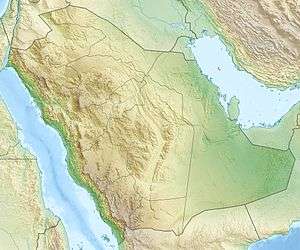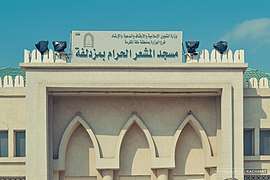Muzdalifah
| Muzdalifah Arabic: مُـزْدَلِـفَـة | |
|---|---|
| City | |
|
Mosque and pebble-collection zone at Muzdalifah | |
 Muzdalifah Location of Mudalifah | |
| Coordinates: Coordinates: 21°23′33″N 39°56′16″E / 21.39250°N 39.93778°E | |
| Country |
|
| Region | Makkah |
| Government | |
| • Regional Governor | Khalid bin Faisal Al Saud |
| Time zone | UTC+3 (Arabia Standard Time) |
Muzdalifah (Arabic: مُـزْدَلِـفَـة) is an open, level area near Mecca in Saudi Arabia that is associated with the Ḥajj (Arabic: حَـجّ, "Pilgrimage").[1][2][3][4] It lies just southeast of Mina, on the route between Mina and Arafat.
Pilgrimage
The stay at Muzdalifah is preceded by a day at Arafat, consisting of glorifying Allāh (Arabic: ٱلله, "The God") repeating the Du‘ā’ (Arabic: دُعَـاء, Supplication), repentance to Allah, and asking Him for forgiveness. At Arafat, Ẓuhr (Arabic: ظُـهْـر) and ʿAṣr (Arabic: عَـصْـر) prayers are performed in a combined and abbreviated form during the time of Zuhr. After sunset on the ninth day of the Islamic month of Dhūl-Ḥijjah (Arabic: ذُو الْـحِـجَّـة), Muslim pilgrims travel to Muzdalifah, sometimes arriving at night because of over-crowding. After arriving at Muzdalifah, pilgrims pray the Maghrib (Arabic: مَـغْـرِب) and ‘Ishā’ (Arabic: عِـشَـاء) prayers jointly, whereas the Isha prayer is shortened to 2 rakats. At Muzdalifah, pilgrims collect pebbles for the Stoning of the Devil (Arabic: رَمِي الْـجَـمَـرَات, translit. Ramī al-Jamarāt, lit. 'Stoning of the Place of Pebbles').[5][6][7]
The Sacred Monument

The open-roofed mosque at Muzdalifah is known as "The Sacred Monument"[1][2][3][4] (Arabic: ٱلْـمَـشْـعَــر الْـحَـرَام, translit. Al-Mash‘ar Al-Ḥarām).[8]
See also
References
- 1 2 Long, David E. (1979). "2: The Rites of the Hajj". The Hajj Today: A Survey of the Contemporary Pilgrimage to Makkah. pp. 11–24. ISBN 0873953827.
With thousands of Hajjis, most of them in motor vehicles, rushing headlong for Muzdalifah, the potential is there for one of ... There is special grace for praying at the roofless mosque in Muzdalifah called al-Mash'ar al-Haram (the Sacred Grove) ...
- 1 2 Danarto (1989). A Javanese pilgrim in Mecca. p. 27. ISBN 0867469390.
It was still dark when we arrived at Muzdalifah, four miles away. The Koran instructs us to spend the night at al-Mash'ar al-Haram. the Sacred Grove at Muzdalifah, as one of the conditions for the hajj . We scrambled out of the bus and looked ...
- 1 2 Jones, Lindsay (2005). Encyclopedia of religion. 10. Macmillan Reference USA. p. 7159. ISBN 0028657438.
The Qur'an admonishes: "When you hurry from Arafat, remember God at the Sacred Grove (al-mash' ar al-haram)," that is, at Muzdalifah (2:198). Today a mosque marks the place in Muzdalifah where pilgrims gather to perform the special saldt ...
- 1 2 Ziauddin Sardar; M. A. Zaki Badawi (1978). Hajj Studies. King Abdul Aziz University. Jeddah: Croom Helm for Hajj Research Centre. p. 32. ISBN 0856646814.
Muzdalifah is an open plain sheltered by parched hills with sparse growth of thorn bushes. The pilgrims spend a night under the open sky of the roofless Mosque, the Sacred Grove, Al Mush'ar al-Haram. On the morning of the tenth, all depart ...
- ↑ Burton, Richard Francis (1857). Personal Narrative of a Pilgrimage to El Medinah and Meccah. p. 226.
The word jamrah is applied to the place of stoning, as well as to the stones.
- ↑ Abū Dāʼūd (1984). Sunan Abu Dawud: Chapters 519-1337. Sh. M. Ashraf.
1204. Jamrah originally means a pebble. It is applied to the heap of stones or a pillar.
- ↑ Hughes, Thomas Patrick (1995) [1885]. Dictionary of Islam. p. 225. ISBN 978-81-206-0672-2.
Literally "gravel, or small pebbles." The three pillars [...] placed against a rough wall of stones [...]
- ↑ Quran 2:129 (Translated by Yusuf Ali)
